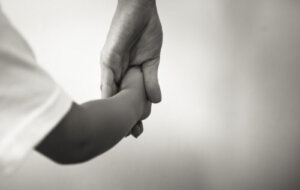Adopted Child Syndrome: Learn What It Is


Written and verified by the psychologist Maria Fátima Seppi Vinuales
Any adoption process poses challenges to a family. Accompanying and understanding the family history that accompanies adopted children requires great sensitivity and compassion. In most cases, these chidlren have had their rights and basic care violated. In addition to the great joy of seeing many dreams come true and the expectation of integrating this new member into the family, other emotions also follow. Uncertainty, doubts, and frustration are typical of any parenting process and carry the nuance of the adopted child syndrome.
Am I doing it right? No one prepared us for this! I never imagined it would be so difficult! These feelings are to be expected, which is why every adoption process requires time and patience. Keep reading to learn more about how to prepare to face this moment.
The characteristics of adopted child syndrome
In many cases, adopted children have lived through complex situations. This may have impacted the establishment of attachment with reference figures. Attachment is necessary for development at all levels: Psychological, physical, social, and emotional.
Hence, some of the following emotions or situations may occur, which are part of what specialists have called “adopted child syndrome”.
- Fear or insecurity about being abandoned.
- Low self-esteem, the feeling of not being good enough and of being worthless.
- Anxiety, anguish, and nervousness.
- Rejection toward the adoptive family or the opposite behavior of complacency, as they need to feel accepted in any way.
- There may be some delays in motor development or language acquisition.
- Regression behaviors. Certain acquired milestones may regress to earlier stages, such as toilet training.
- Their development may seem to be slow compared to other peers or not progressing at all but then, all of a sudden, it does.
- In adolescence, behaviors of opposition, defiance, or rejection of the family may occur. Sometimes these are ways of testing support and affection.
- Episodes of aggression and violence.
- Moments of anguish or flashbacks. Many of them are the result of post-traumatic stress.

Knowing their previous history is key to knowing their needs
Adopted child syndrome should be health with carefully. The presence or absence of some indicators such as those mentioned above or the complexity of the situation depends very much on the child’s previous history. Some experienced maltreatment, while others were exposed to abusive situations. In other words, their development and what they need will depend on each particular case, but if there’s a common denominator, it’s that they all need support, affection, and recognition of their rights.
How to deal with adopted child syndrome
Some of the tips to facilitate the adaptation of adopted children and their well-being are presented below:
- Each adoption-related experience is unique. That’s to say, there’s no universal rule that will be fulfilled nor an irrevocable destiny. It’s very important to keep this in mind because each child needs something different.
- It’s not correct and is inadvisable to hide the child’s own history from them. It’s a right for adopted children to know their origins. However, it’s important to be prepared, to know that questions may arise and certain emotions may be aroused that can’t be left unresolved. It’s crucial that you’re available and offer help.
- Talk about the great diversity of families that exist. For example, there are homes where there’s only one parent or where the couple is made up of two members of the same sex. Validating the multiple ways of being a family and emphasizing the importance of love, respect, and mutual care is key.
- Any adaptation process requires time and patience, both for the child and for the family and its other members. Accompaniment is necessary. In some cases, parents may even have doubts and require professional advice.
- It’s necessary to accompany in the management of emotions, as they can fluctuate without apparent explanation. For example, children with adopted child syndrome may go from crying to laughing from one moment to the next.
- You should also keep in mind that the age of adoption is a variable to keep in mind. It’s one thing to adopt a child in their first months of life, but adopting an older child is altogether different. Another point to consider is that there are cases of children coming from other countries. This implies that they may have been socialized in another language and under other customs. In this case, you shouldn’t take for granted that they understand everything we do or what’s going on.

Don’t stereotype adoption
In order to give care and support, it’s important to take into account the individual child you have in front of you. You must avoid stereotyping children who’ve been adopted in order to avoid prejudices or stigmas. Sometimes, these prejudices are installed from the outside and are extremely counterproductive. Labeling can work as an inevitable fate. This will only make it more difficult to build trust and establish a secure bond. It may even appear that adoption is a bad thing and the possibility of moving forward is blocked.
We must stop focusing on the deficit and the negative aspects of adoption and facilitate all those conditions that are necessary for healthy development. There are families who are willing to do so, with great interest in giving a new opportunity and a new beginning to children.
Any adoption process poses challenges to a family. Accompanying and understanding the family history that accompanies adopted children requires great sensitivity and compassion. In most cases, these chidlren have had their rights and basic care violated. In addition to the great joy of seeing many dreams come true and the expectation of integrating this new member into the family, other emotions also follow. Uncertainty, doubts, and frustration are typical of any parenting process and carry the nuance of the adopted child syndrome.
Am I doing it right? No one prepared us for this! I never imagined it would be so difficult! These feelings are to be expected, which is why every adoption process requires time and patience. Keep reading to learn more about how to prepare to face this moment.
The characteristics of adopted child syndrome
In many cases, adopted children have lived through complex situations. This may have impacted the establishment of attachment with reference figures. Attachment is necessary for development at all levels: Psychological, physical, social, and emotional.
Hence, some of the following emotions or situations may occur, which are part of what specialists have called “adopted child syndrome”.
- Fear or insecurity about being abandoned.
- Low self-esteem, the feeling of not being good enough and of being worthless.
- Anxiety, anguish, and nervousness.
- Rejection toward the adoptive family or the opposite behavior of complacency, as they need to feel accepted in any way.
- There may be some delays in motor development or language acquisition.
- Regression behaviors. Certain acquired milestones may regress to earlier stages, such as toilet training.
- Their development may seem to be slow compared to other peers or not progressing at all but then, all of a sudden, it does.
- In adolescence, behaviors of opposition, defiance, or rejection of the family may occur. Sometimes these are ways of testing support and affection.
- Episodes of aggression and violence.
- Moments of anguish or flashbacks. Many of them are the result of post-traumatic stress.

Knowing their previous history is key to knowing their needs
Adopted child syndrome should be health with carefully. The presence or absence of some indicators such as those mentioned above or the complexity of the situation depends very much on the child’s previous history. Some experienced maltreatment, while others were exposed to abusive situations. In other words, their development and what they need will depend on each particular case, but if there’s a common denominator, it’s that they all need support, affection, and recognition of their rights.
How to deal with adopted child syndrome
Some of the tips to facilitate the adaptation of adopted children and their well-being are presented below:
- Each adoption-related experience is unique. That’s to say, there’s no universal rule that will be fulfilled nor an irrevocable destiny. It’s very important to keep this in mind because each child needs something different.
- It’s not correct and is inadvisable to hide the child’s own history from them. It’s a right for adopted children to know their origins. However, it’s important to be prepared, to know that questions may arise and certain emotions may be aroused that can’t be left unresolved. It’s crucial that you’re available and offer help.
- Talk about the great diversity of families that exist. For example, there are homes where there’s only one parent or where the couple is made up of two members of the same sex. Validating the multiple ways of being a family and emphasizing the importance of love, respect, and mutual care is key.
- Any adaptation process requires time and patience, both for the child and for the family and its other members. Accompaniment is necessary. In some cases, parents may even have doubts and require professional advice.
- It’s necessary to accompany in the management of emotions, as they can fluctuate without apparent explanation. For example, children with adopted child syndrome may go from crying to laughing from one moment to the next.
- You should also keep in mind that the age of adoption is a variable to keep in mind. It’s one thing to adopt a child in their first months of life, but adopting an older child is altogether different. Another point to consider is that there are cases of children coming from other countries. This implies that they may have been socialized in another language and under other customs. In this case, you shouldn’t take for granted that they understand everything we do or what’s going on.

Don’t stereotype adoption
In order to give care and support, it’s important to take into account the individual child you have in front of you. You must avoid stereotyping children who’ve been adopted in order to avoid prejudices or stigmas. Sometimes, these prejudices are installed from the outside and are extremely counterproductive. Labeling can work as an inevitable fate. This will only make it more difficult to build trust and establish a secure bond. It may even appear that adoption is a bad thing and the possibility of moving forward is blocked.
We must stop focusing on the deficit and the negative aspects of adoption and facilitate all those conditions that are necessary for healthy development. There are families who are willing to do so, with great interest in giving a new opportunity and a new beginning to children.
All cited sources were thoroughly reviewed by our team to ensure their quality, reliability, currency, and validity. The bibliography of this article was considered reliable and of academic or scientific accuracy.
- Sánchez-Sandoval, Yolanda, & Palacios, Jesús. (2012). Problemas emocionales y comportamentales en niños adoptados y no adoptados. Clínica y Salud, 23(3), 221-234. https://dx.doi.org/10.5093/cl2012a14
- Gómez Muzzio S, Esteban, Muñoz, María Magdalena, & Santelices, María Pía. (2008). Efectividad de las Intervenciones en Apego con Infancia Vulnerada y en Riesgo Social: Un Desafío Prioritario para Chile. Terapia psicológica, 26(2), 241-251. https://dx.doi.org/10.4067/S0718-48082008000200010
This text is provided for informational purposes only and does not replace consultation with a professional. If in doubt, consult your specialist.








